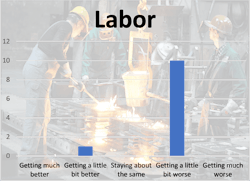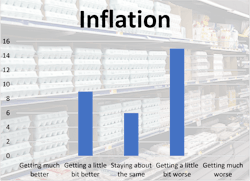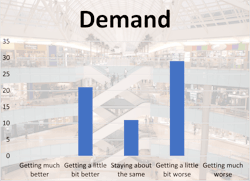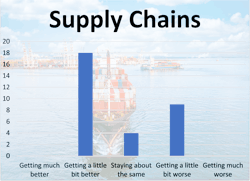Industrial Executives’ Sentiment Was Slipping Even Before Tariffs [Tales From the Transcript]
This is an unusual edition of Tales From the Transcript and it’s not at all surprising why.
The economy and the business climate have taken on a decidedly before-and-after vibe since President Trump’s April 2 event detailing the tariffs he and his team devised for most of the United States’ trading partners. And while he retreated from several measures less than a week later, the ones left in force—led by the across-the-board minimum 10% tariff rate that came into effect April 5—are reshaping trade flows around the globe.
That means our newest quarterly analysis of forward-looking statements made during the earnings calls of leading names in 10 sectors of the IndustryWeek U.S. 500 list of public manufacturing companies serves more as a pre-tariff snapshot than as a rough guide to their health for the rest of 2025. Yes, many CEOs and CFOs discussed tariffs that the Trump administration had already implemented as well as the prospect of future ones. But today’s reality is quite different from the one in which they were framing those thoughts and outlooks.
The scores and summaries listed here reflect conference calls that started in late January. Per usual, we’ve lined them up starting with the most negative reading before getting progressively more positive. Worth noting, though, is that “positive” is relative this go-around: For the first time since our 2022 third-quarter report—when inflation, labor and supply-chain woes were competing to be Problem No. 1—three of our four components are negative.
Labor: -0.41 (-0.08 in Q3 and -0.03 in Q2)
We’ll start out with a caveat here: The number of workforce-related notes by executive teams shrank significantly last quarter, something we’ll attribute to a softening labor market that has eased complaints of shortages and/or wage pressures, one of the most consistent threads we’ve followed since launching these analyses in 2022.
Still, the very negative reading here—which was “beaten” only by our inflation gauge in the fall of 2022—is notable and attributable in large part to conversations about layoffs and cost-cutting from corporations. Among the teams discussing such moves were chemical giant Dow Inc., engine builder Cummins Inc. and agricultural equipment maker Alamo Group Inc. Leaders of the last of that group noted they cut 14% of their workforce last year as sales of their products slumped.
Inflation: -0.10 (0.03 in Q3 and 0.02 in Q2)
Our analysis of third-quarter commentary late last year flagged some concerns about pricing pressures but cushioned them with executives’ confidence in their abilities to pass along those increases. One earnings season later, the tone shifted toward caution and away from the rough price-cost equilibrium that had existed for a while: The share of negative comments outweighed generally positive ones for the first time since the fall of 2023 and our -0.10 reading is the worst since the summer of that year.
Given that we’re thinking of this feature as providing the “then” view compared to the “now” we’ve been in since April 2, we’re not picking on Applied Industrial Technologies Inc. President and CEO Neil Schrimsher or W.W. Grainger Inc. CFO Deidra Merriwether when we point out the following quotes. We’re only including them as representatives of how much the calculus has changed since.
Speaking about seeing “no signs of disinflation” from AIT’s supplier base, Schrimsher nevertheless said the tariff situation at the time had his team thinking inflation would have a “less than 100 basis points impact […] That would be our current expectation for the back half of the fiscal year aside of any other significant policy change.”
Similarly, Merriwether said her teams were “not seeing the supplier inflation that then would translate into price inflation like what you're seeing from some […] market indexes.”
It’s fair to postulate that expectations have changed since late January along with policy—and may evolve further still by the time July’s reporting window opens.
Demand: -0.07 (0.03 in Q3 and -0.04 in Q2)
A similar shift in conversation as with inflation took shape around demand during the conference calls we tracked early this year: Our overall score slid and the share of negative forward-looking comments was the highest since we began compiling this data.
Some economists—Neil Dutta of Renaissance Macro in the lead—have been saying that the U.S. economy was weakening coming into 2025 irrespective of a changing international trade regime. A handful of executive teams were blunt in sharing assessments to that effect: Leaders of both Stanley Black & Decker Inc. and Sherwin-Williams Co. said “several end markets may not improve until 2026.”
Put differently, the consensus clearly leaned toward the idea that there was little margin of safety from shocks in early 2025. O-I Glass Inc. CEO Gordon Hardie talked succinctly about waning household confidence leading his team to adopt a cautious stance on sales for 2025 even as they work on efficiency projects that should lift earnings.
“There is still some way to go to align consumer real income with the inflation experienced over the past few years and to see destocking moderate across the value chain,” Hardie told analysts in early February.
Supply chain: 0.15 (-0.03 in Q3 and 0.26 in Q2)
Still, tariffs were rising quickly up the agenda during reporting season—and perhaps suggesting a quick return to negative readings. At auto parts supplier Lear Corp., President and CEO Ray Scott said in early February that suppliers had been reaching out with “all kinds of different requests” related to tariffs.
“At the end of the day, it’s going to lead to a lot of shutdowns and a lot of intermittent downtime,” Scott said of the automotive supply chain.
Dan Fisher, CEO of aluminum packaging company Ball Corp., had perhaps the most precise tariff anecdote of a season in which relatively few executives would be drawn into tariff-related numerical detail:
“We have spent the better part of the last few weeks mitigating what started as a potential $40 million to $50 million issue,” Fisher said. “I think we've got that resolved down to […] a couple million dollars. So we've renegotiated deals with the supply base.”
In our new trade-warring world, it’s looking like it’s time to repeat that trick many times over across the industrial economy.
About the Author
Geert De Lombaerde
Senior Editor
A native of Belgium, Geert De Lombaerde has been in business journalism since the mid-1990s and writes about public companies, markets and economic trends for Endeavor Business Media publications, focusing on IndustryWeek, FleetOwner, Oil & Gas Journal, T&D World and Healthcare Innovation. He also curates the twice-monthly Market Moves Strategy newsletter that showcases Endeavor stories on strategy, leadership and investment and contributes to other Market Moves newsletters.
With a degree in journalism from the University of Missouri, he began his reporting career at the Business Courier in Cincinnati in 1997, initially covering retail and the courts before shifting to banking, insurance and investing. He later was managing editor and editor of the Nashville Business Journal before being named editor of the Nashville Post in early 2008. He led a team that helped grow the Post's online traffic more than fivefold before joining Endeavor in September 2021.




